TI Stellaris LM3S2000混合动力汽车电池充电器解决方案
发布时间:2012-1-7 13:46
发布者:1046235000
|
TI公司的Level 3电动/混合动力汽车电池充电器采用数字功率控制器,通信器件,高性能驱动器以及接口器件. Level 3充电器包括从AC产生DC电压的带PFC的AC/DC转换器,DC/DC转换器,其核心器件是实时C2000系列MCU.本文介绍了EV/HEV充电器方框图以及EV/HEV充电器主控制器Stellaris LM3S2000 32位MCU主要特性,方框图, 开发板主要特性和方框图,电路图和PCB元件布局图. Block Diagram (SBD) EV/HEV Charger Level 3 using TI’s Digital Power Controllers, communication devices, high performance drivers and interface devices. Plug-in Hybrid Electric Vehicles (PHEV) and Battery Electric Vehicles (BEV) are two quickly emerging technologies which use powerful electric motors and high voltage battery packs as the propulsion and energy sources. Since batteries have a finite energy capacity, PHEV and BEV must be recharged on a periodic basis, typically by connecting to the power grid. When doing so, some form of communication (PLC, wireless, or RFID) might be used to manage the charging activity and aid in identifying and authenticating the vehicle or owner for billing purposes. Level 3 charging will play a key role in the public charging area in order to reduce the charging time and make it more feasible for the user to benefit from on-the-go charging. The Level 3 charging system for these vehicles consists of an AC/DC converter to generate a DC voltage from the AC line. This incoming power needs to undergo power factor correction (PFC) to boost the power factor to meet regional regulatory standards. At the heart of the inverter is a real-time C2000 microcontroller. This controller is programmed to perform the control loops for all necessary power management functions, including AC/DC with PFC and DC/DC to create the necessary charge profile for the battery. The C2000 controller contains advanced peripherals such as high precision PWM outputs and ADCs, and is designed to read the ADC and adjust the PWM within a single clock cycle making real time control possible. While the C2000 manages the power, the host controller will have the responsibility using the information provided by the communications modem and temperature sensing to drive a display and communicate directly with the on-board battery pack. The necessary information for the charge profile will be delivered to the power controller and important charging diagnostics and battery status will be sent to the display of the Level 3 charging system. For safety reasons, isolation between the processor and the current and voltage is also required, as well as on the communications bus to the outside world. TI digital isolators have logic input and output buffers separated by TI’s silicon dioxide (SiO2) isolation barrier, providing 4kV of isolation. Used in conjunction with isolated power supplies, these devices block high voltage, isolate grounds, and prevent noise currents from entering the local ground and interfering with or damaging sensitive circuitry. High-performance analog parts are also available to provide critical system functions such as MOSFET drivers, sensor feedback, chip power supplies, and communication transceivers. Communications on a simple system can be handled by a single processor. More elaborate systems with complex displays and online billing/reporting, such as Level 3 charging, may require a secondary controller. Implementing a Low Frequency NarrowBand PLC (LF NB PLC) solution provides an optimal fit in terms of bandwidth, power, and cost requirements. Operating in the narrowband domain (frequencies up to 500 kHz) ensures data integrity while minimizing system cost. In doing so, this standard would leverage the existing power line infrastructure and provide a cost-effective means of integrating intelligent monitoring and control into new automotive systems. Data rates can vary from 1.2 kbps up to hundreds of kbps based on the existing standards. TI’s PLC software is delivered in the plcSUITE library and enables developers to support several modulations and standards on one unique design. Developers can implement SFSK IEC61334, PRIME and G3 standards as well as FlexOFDM for custom OFDM implementation and is scalable for the incoming standards. For details, visit our PLC Applications Page. In addition, wireless communication and/or RFID may be needed as a secondary communication protocol and as a means of identification and billing. 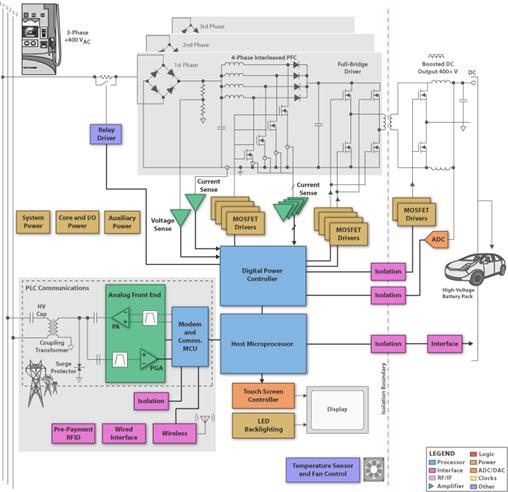
图1. EV/HEV充电器方框图 EV/HEV充电器主控制器Stellaris LM3S2000 32位MCU The Stellaris LM3S2000 series, designed for Controller Area Network (CAN) applications, extends the Stellaris family with Bosch CAN networking technology, the golden standard in short-haul industrial networks. This introduction marks the first integration of CAN capabilities with the revolutionary ARM® Cortex™-M3 core. In addition, several LM3S2000 Series MCUs are offered with StellarisWare® software features preprogrammed in memory-saving ROM. Texas Instruments is the industry leader in bringing 32-bit capabilities and the full benefits of ARM® Cortex™-M3-based microcontrollers to the broadest reach of the microcontroller market. For current users of 8- and 16-bit MCUs, Stellaris with Cortex-M3 offers a direct path to the strongest ecosystem of development tools, software and knowledge in the industry. Designers who migrate to Stellaris benefit from great tools, small code footprint and outstanding performance. Even more important, designers can enter the ARM ecosystem with full confidence in a compatible roadmap from $1 to 1 GHz. For users of current 32-bit MCUs, the Stellaris family offers the industry’s first implementation of Cortex-M3 and the Thumb-2 instruction set. With blazingly-fast responsiveness, Thumb-2 technology combines both 16-bit and 32-bit instructions to deliver the best balance of code density and performance. Thumb-2 uses 26 percent less memory than pure 32-bit code to reduce system cost while delivering 25 percent better performance. The Texas Instruments Stellaris family of microcontrollers—the first ARM Cortex-M3 based controllers—brings high-performance 32-bit computing to cost-sensitive embedded microcontroller applications. These pioneering parts deliver customers 32-bit performance at a cost equivalent to legacy 8- and 16-bit devices, all in a package with a small footprint. The LM3S2B93 microcontroller has the following features: LM3S2B93 MCU主要特性: ■ ARM Cortex-M3 Processor Core – 80-MHz operation; 100 DMIPS performance – ARM Cortex SysTick Timer – Nested Vectored Interrupt Controller (NVIC) ■ On-Chip Memory – 256 KB single-cycle Flash memory up to 50 MHz; a prefetch buffer improves performance above 50 MHz – 96 KB single-cycle SRAM – Internal ROM loaded with StellarisWare software: • Stellaris Peripheral Driver Library • Stellaris Boot Loader • Advanced Encryption Standard (AES) cryptography tables • Cyclic Redundancy Check (CRC) error detection functionality ■ External Peripheral Interface (EPI) – 8/16/32-bit dedicated parallel bus for external peripherals – Supports SDRAM, SRAM/Flash memory, FPGAs, CPLDs ■ Advanced Serial Integration – Two CAN 2.0 A/B controllers – Three UARTs with IrDA and ISO 7816 support (one UART with modem flow control and status) – Two I2C modules – Two Synchronous Serial Interface modules (SSI) – Integrated Interchip Sound (I2S) module ■ System Integration – Direct Memory Access Controller (DMA) – System control and clocks including on-chip precision 16-MHz oscillator – Four 32-bit timers (up to eight 16-bit) – Eight Capture Compare PWM pins (CCP) – Lower-power battery-backed hibernation module – Real-Time Clock in Hibernation module – Two Watchdog Timers • One timer runs off the main oscillator • One timer runs off the precision internal oscillator – Up to 67 GPIOs, depending on configuration • Highly flexible pin muxing allows use as GPIO or one of several peripheral functions • Independently configurable to 2, 4 or 8 mA drive capability • Up to 4 GPIOs can have 18 mA drive capability ■ Advanced Motion Control – Eight advanced PWM outputs for motion and energy applications – Four fault inputs to promote low-latency shutdown – Two Quadrature Encoder Inputs (QEI) ■ Analog – Two 10-bit Analog-to-Digital Converters (ADC) with 16 analog input channels and a sample rate of one million samples/second – Three analog comparators – 16 digital comparators – On-chip voltage regulator ■ JTAG and ARM Serial Wire Debug (SWD) ■ 100-pin LQFP package ■ 108-ball BGA package ■ Industrial (-40℃ to 85℃) Temperature Range The LM3S2B93 microcontroller is targeted for industrial applications, including remote monitoring, electronic point-of-sale machines, test and measurement equipment, network appliances and switches, factory automation, HVAC and building control, gaming equipment, motion control, transportation, and fire and security. For applications requiring extreme conservation of power, the LM3S2B93 microcontroller features a battery-backed Hibernation module to efficiently power down the LM3S2B93 to a low-power state during extended periods of inactivity. With a power-up/power-down sequencer, a continuous time counter (RTC), a pair of match registers, an APB interface to the system bus, and dedicated non-volatile memory, the Hibernation module positions the LM3S2B93 microcontroller perfectly for battery applications. In addition, the LM3S2B93 microcontroller offers the advantages of ARM’s widely available development tools, System-on-Chip (SoC) infrastructure IP applications, and a large user community. Additionally, the microcontroller uses ARM’s Thumb®-compatible Thumb-2 instruction set to reduce memory requirements and, thereby, cost. Finally, the LM3S2B93 microcontroller is code-compatible to all members of the extensive Stellaris family; providing flexibility to fit our customers’ precise needs. Texas Instruments offers a complete solution to get to market quickly, with evaluation and development boards, white papers and application notes, an easy-to-use peripheral driver library, and a strong support, sales, and distributor network. See “Ordering and Contact Information” on page 1180 for ordering information for Stellaris family devices. 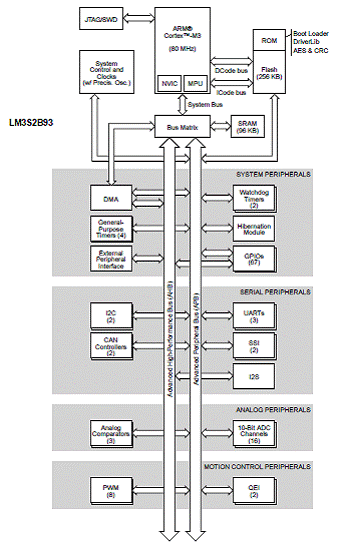
图2. LM3S2B93 MCU方框图 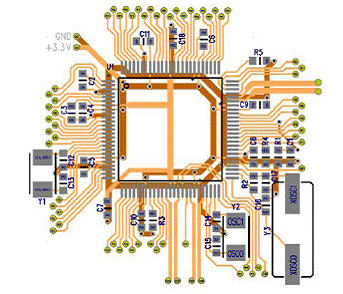
图3. LM3S2B93 MCU最基本连接电路图 其中各元件如下: Pull-up resistors might also be needed on JTAG signals if these pins are not driven externally. VDD, VDDC and GND connections are shown as thick PCB traces for clarity. Normally these connections would be extended as copper pours. • R1 Reset input pull-up resistor • C1 Reset input filter capacitor • C3 LDO regulator filter capacitor • C2, C4-C6, C11 VDD Decoupling capacitors • C7, C18 VDDC Decoupling capacitors • C12-C17 Crystal load capacitors • Y1 Ethernet Crystal • Y2 Main Oscillator Crystal • Y3 Hibernate Module Crystal • R3 Ethernet RBIAS resistor • R2 Hibernate Oscillator resistor • R5 USB RBIAS • R4 MDIO Pull-up resistor Stellaris® LM3S9B96开发板 Stellaris® LM3S9B96 Development Kit The Stellaris® LM3S9B96 Development Board provides a platform for developing systems around the advanced capabilities of the LM3S9B96 ARM® Cortex™-M3-based microcontroller. The LM3S9B96 is a member of the Stellaris Tempest-class microcontroller family. Tempest-class devices include capabilities such as 80 MHz clock speeds, an External Peripheral Interface (EPI) and Audio I2S interfaces. In addition to new hardware to support these features, the DK-LM3S9B96 board includes a rich set of peripherals found on other Stellaris boards. The development board includes an on-board in-circuit debug interface (ICDI) that supports both JTAG and SWD debugging. A standard ARM 20-pin debug header supports an array of debugging solutions. The Stellaris® LM3S9B96 Development Kit accelerates development of Tempest-class microcontrollers. The kit also includes extensive example applications and complete source code. Stellaris® LM3S9B96开发板主要特性: The Stellaris® LM3S9B96 Development Board includes the following features. Simple set-up—USB cable provides debugging, communication, and power Flexible development platform with a wide range of peripherals Color LCD graphics display – TFT LCD module with 320 x 240 resolution – Resistive touch interface 80 MHz LM3S9B96 microcontroller with 256 K Flash, 96 K SRAM, and integrated Ethernet MAC+PHY, USB OTG, and CAN communications – – 8 MB SDRAM (plug-in EPI option board) – – EPI break-out board (plug-in option board) 1 MB serial Flash memory Precision 3.00 V voltage reference SAFERTOS™ operating system in microcontroller ROM I2S stereo audio codec – Line In/Out – Headphone Out – Microphone In Controller Area Network (CAN) Interface 10/100 BaseT Ethernet USB On-The-Go (OTG) Connector Device, Host, and OTG modes User LED and push button Thumbwheel potentiometer (can be used for menu navigation) MicroSD card slot Supports a range of debugging options – Integrated In-circuit Debug Interface (ICDI) – JTAG, SWD, and SWO all supported – Standard ARM® 20-pin JTAG debug connector USB Virtual COM Port Jumper shunts to conveniently reallocate I/O resources Develop using tools supporting Keil™ RealView® Microcontroller Development Kit(MDK-ARM), IAR Embedded Workbench, Code Sourcery GCC development tools, Code Red Technologies development tools, or Texas Instruments’ Code Composer Studio™ IDE Supported by StellarisWare® software including the graphics library, the USB library, and the peripheral driver library Optional expansion boards that work with the External Peripheral Interface (EPI) of the DK-LM3S9B96 development board extend the capabilities of this development platform (each board sold separately) – Stellaris® Flash and SRAM Memory Expansion Board (DK-LM3S9B96-FS8) (sold separately) • Provides Flash memory, SRAM, and an improved performance LCD interface For more information on the DK-LM3S9B96-FS8 memory expansion board, see Appendix E, “Stellaris® LM3S9B96 Flash and SRAM Memory Expansion Board,” on page 41. – Stellaris® FPGA Expansion Board (DK-LM3S9B96-FPGA) (sold separately) • Provides machine-to-machine (M2M), high-bandwidth, parallel interface capability of the Stellaris microcontroller • Allows users to control and display the FPGA expansion board’s video on the DK-LM3S9B96 development board’s large, 3.5” touchscreen display For more information on the DK-LM3S9B96-FPGA expansion board. – Stellaris® EM2 Expansion Board (DK-LM3S9B96-EM2) (sold separately) • Provides a transition between the Stellaris External Peripheral Interface (EPI) connector and the RF Evaluation Module (EM) connector • Enables wireless application development using Low Power RF and RF ID evaluation modules on the Stellaris DK-LM3S9B96 platform 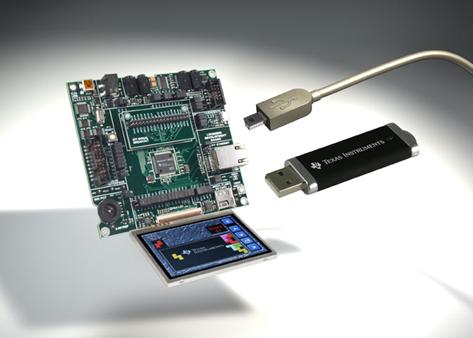
图4. DK-LM3S9B96开发板外形图 The Stellaris® LM3S9B96 Development Kit contains everything needed to develop and run a range of applications using Stellaris microcontrollers: LM3S9B96 development board 8 MB SDRAM expansion board EPI signal breakout board Retractable Ethernet cable USB Mini-B cable for debugger use USB Micro-B cable for OTG-to-PC connection USB Micro-A to USB A adapter for USB Host USB Flash memory stick microSD Card 20-position ribbon cable CD containing: – A supported version of one of the following (including a toolchain-specific Quickstart guide): • Keil™ RealView® Microcontroller Development Kit (MDK-ARM) • IAR Embedded Workbench • Code Sourcery GCC development tools • Code Red Technologies development tools • Texas Instruments’ Code Composer Studio™ IDE – Complete documentation Quickstart application source code Stellaris® Firmware Development Package with example source code 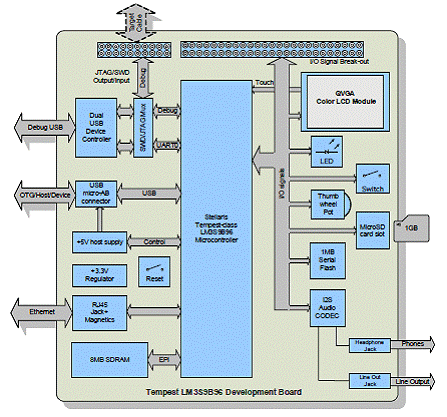
图5.DK-LM3S9B96开发板方框图 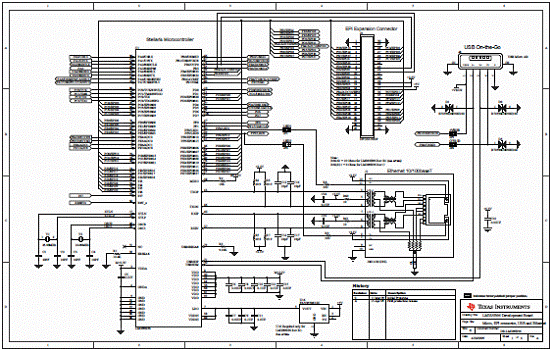
图6.DK-LM3S9B96开发板电路图(1) 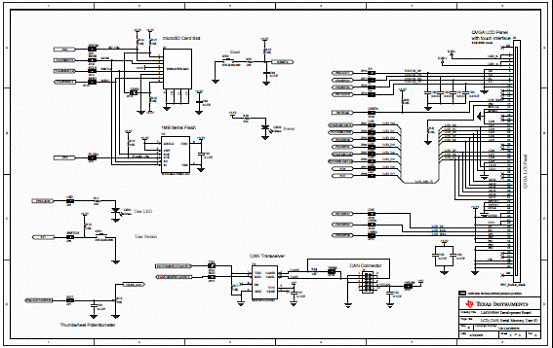
图7.DK-LM3S9B96开发板电路图(2) 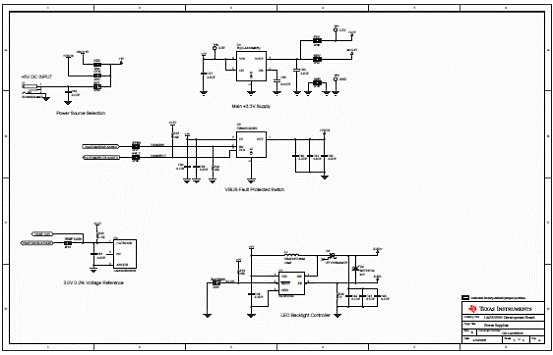
图8.DK-LM3S9B96开发板电路图(3) 
图9.DK-LM3S9B96开发板电路图(4) 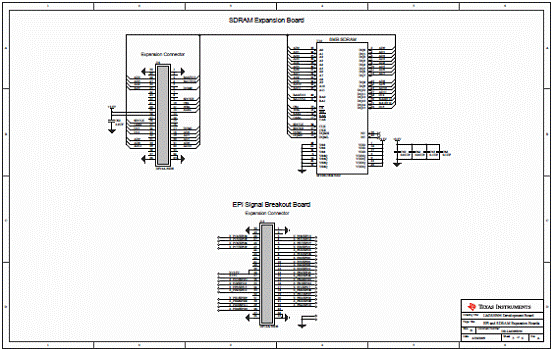
图10.DK-LM3S9B96开发板电路图(5) 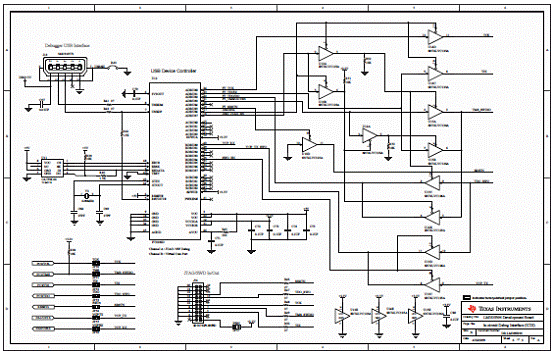
图11.DK-LM3S9B96开发板电路图(6) 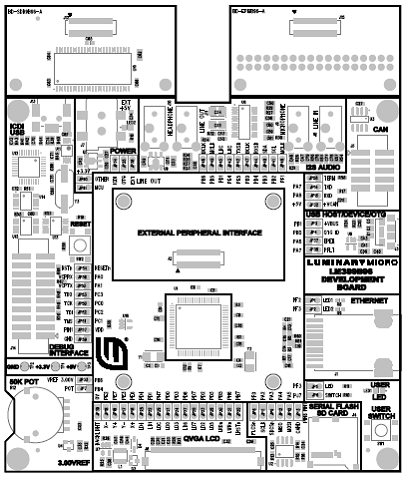
图12.DK-LM3S9B96开发板PCB顶层元件布局图 详情请见:  spms063l[1].pdf
(6.71 MB)
spms063l[1].pdf
(6.71 MB)
 spmu036g[1].pdf
(1.67 MB)
spmu036g[1].pdf
(1.67 MB)
|







网友评论